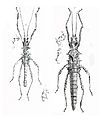Hoploclonia gecko
| Hoploclonia gecko | ||||||||||||
|---|---|---|---|---|---|---|---|---|---|---|---|---|

Hoploclonia gecko , |
||||||||||||
| Systematics | ||||||||||||
|
||||||||||||
| Scientific name | ||||||||||||
| Hoploclonia gecko | ||||||||||||
| ( Westwood , 1859) |
Hoploclonia gecko is a relatively small, prickly and dark-colored ghost species thatis native tothe northwest of the island of Borneo .
features
The animals, wingless in both sexes, have typical thorns on their bodies like all representatives of this genus. In the 30 to 35 millimeter long males, these are found in pairs on the head and thorax , but not on the abdomen . The pair of spines on the pronotum is forked on them. In adult males, a dark, mostly black-brown basic color dominates with a bright yellow-orange to red longitudinal line, which extends from the rear edge of the pronotum to the middle of the abdomen. As with the other representatives of the genus, the areas around the hips , as well as the distal ends of the thighs and the proximal ends of the splints , i.e. the knee area, are colored light yellow to orange.
The females are 40 to 50 millimeters long. They can be colored more or less high-contrast light, dark or red-brown. They have clear spines on the thorax. On the mesothorax, the first pair of spines forms a flat triangle that is very broad at the base, which is much more pronounced than on other Hoploclonia species. Overall, their habitus is very robust. The relatively short abdomen in egg-laying females is plump and approximately cylindrical in cross-section. The end of the abdomen is formed by a short laying spine, which is used to deposit the eggs in the ground.
distribution
Hoploclonia gecko is native to the northwest of Borneo, more precisely in the far west of the Malaysian state of Sarawak . The species was found here in the Bako National Park , on Mount Santubong , on Mount Serapi , in Matang and Lingga . The main area of distribution is the area around Kuching , the capital of the state of Sarawak. On Mount Santubong she was found up to a height of 300 meters.
Way of life and reproduction
Like almost all ghost horrors, Hoploclonia gecko is nocturnal. To eat, they do not climb up the food plants higher than 30 cm. The females lay their eggs with the laying stinger only a few millimeters deep in the ground. The eggs are 4.1 to 4.2 mm long, 2.9 to 3.0 mm high and 2.6 to 2.7 mm wide. Like all Hoploclonia species, they are more arched on the dorsal side and have a lid sloping down towards the ventral side, which forms an opercular angle of less than 10 degrees. One of the three legs of the micropylar plate faces the lid, while the other two run laterally in the direction of the lower pole and enclose about 2/3 of the egg (see also the construction of the phasmid egg ).
Systematics
Alfred Russel Wallace collected a number of animals in Sarawak in 1858 (he did not provide any more precise information about the location), which John Obadiah Westwood described as Acanthoderus gecko the following year . When describing it, both males and females were available to him. Because of the specific epithet chosen by Westwood , it is called "Gecko Stick Insect" in English .
In 1875 Carl Stål established the genus Hoploclonia for this species alone , which made Hoploclonia gecko a type . The genus remained monotypical until the description of Hoploclonia cuspidata in 1906 .
In 1995, a female was selected by Philip Bragg from the animals collected by Wallace as a lectotype . It is deposited in the Natural History Museum in London together with two male paralectotypes . Other animals collected by Wallace are kept as paralectotypes in the Oxford University Museum of Natural History .
Terrariums
Hoploclonia gecko was the first species of the genus to appear in terraristics at the end of the 1980s . Philip Bragg collected some animals in December 1987 in the Bako National Park, which he was able to successfully reproduce and spread. He brought further representatives of this kind with him from Mount Serapi in 1990. The species received PSG number 110 from the Phasmid Study Group
. All that is needed for keeping and breeding is small terrariums with high humidity and a substrate for laying eggs. Leaves of blackberries , raspberries , oaks , ivy , hawthorn and firethorn are accepted as food .
photos
Adult male
Original drawing from Westwood's first description from 1859
Web links
Individual evidence
- ↑ a b c Phasmid page from ( Memento of the original from May 2, 2011 in the Internet Archive ) Info: The archive link was automatically inserted and not yet checked. Please check the original and archive link according to the instructions and then remove this notice. Frank H. Hennemann & Oskar V. Conle
- ^ A b c Philip E. Bragg : Phasmids of Borneo. Natural History Publications (Borneo) Sdn. Bhd., Kota Kinabalu, Sabah, Malaysia 2001, ISBN 983-812-027-8 , pp. 110-111, pp. 120-123.
- ^ Paul D. Brock : Phasmida Species File Online . Version 2.1 / 4.1. (accessed on July 1, 2012)
- ^ John Obadiah Westwood : Catalog of the orthopterous insects in the collection of the British Museum. Part I. Phasmidae. London 1859, p. 52 & Plate XXVI: 6-7 ( online version )
- ↑ Phasmid Study Group Culture List ( Memento from December 5, 2012 in the web archive archive.today ) (English)


